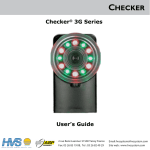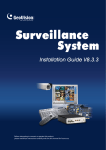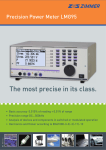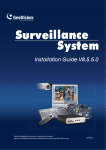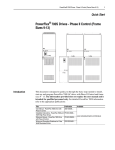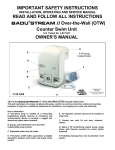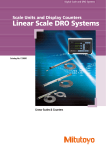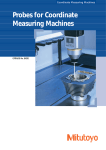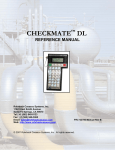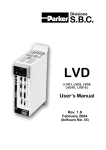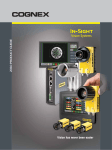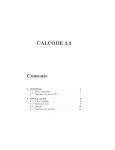Download Quick Reference
Transcript
Quick Reference About Checker™ • • Checker is the sensor. CheckMate™ is the software that runs on your PC. You use CheckMate to set up Checker. Minimum PC Requirements • Microsoft® Windows® 2000 or Windows XP • • • • 400MHz Pentium® III CPU 128 MB RAM USB version 1.1 1024 by 768 Display Physical Description Checker Status Indicator (Green LED) On = Run mode 1 Blink/sec = Setup Mode 4 Blinks/sec = Internal Error Part Status Indicator (Red LED) Focus Adjustment Focus Lock M3 (1.5 mm hex) Power and I/O Cable USB Connector Dimensions and Mounting 45.9 mm 1.806” 53.2 mm 2.094” 39.4 mm 1.550” 19.8 mm 0.778” 19.5 mm 0.772” 60.3 mm 2.375” 129.2 mm 5.087” 111.6 mm 4.383” 3X mounting holes M4x0.70 thread 0.32”deep Getting Started 1 Install the CheckMate Software 1 2 Insert the CheckMate CD-ROM in your PC’s CD-ROM drive. The CheckMate install program will start automatically. You must have Administrator rights on your PC to install CheckMate. Follow the on-screen prompts to install CheckMate. 2 Install the Checker Sensor 1 Mount Checker using 3 M4x0.70 screws. The mounting should provide a suitable path to earth ground. ! 2 3 4 Checker comes with three sets of mounting screws of different lengths; choose the correct length for your mounting. Connect your 24 VDC power supply, as shown in the section Connecting Checker. Connect Checker to your PC using supplied USB cable. Connect input and output devices, as shown in the section Connecting Checker. 3 Start the CheckMate Software Start CheckMate by double-clicking on the CheckMate icon. (The first time that you start CheckMate, it may take a moment before your PC recognizes Checker.) Questions and Answers Checker Status Job Setup Steps Controls Filmstrip Filmstrip Control CheckMate always displays a list of questions and answers related to the current state of CheckMate. ! For detailed information on how Checker works and how to use CheckMate, click on the button to open the User’s Manual. Setting Up Your Job A Checker job contains all of the information that Checker needs to check your part. You set up a Checker job in four simple steps using CheckMate. 1 1. Get Started • Create a new job. • • Enter your line speed and direction. Place a ruler at the same distance from Checker as your part will be, and enter the size of Checker’s field of view. If you specify a horizontal machine direction, this size is the distance between the left and right edges of what Checker can see; if you specify a vertical machine direction, the size is the distance between the top and bottom of what Checker can see. Adjust the image brightness and focus Checker on your part. • ! Checker is shipped with its focus unlocked. If you have tightened the focus lock, make sure to loosen it before adjusting the focus. 2 Detect My Part Before Checker inspects your part, it must detect that your part is present. Checker can detect your part in two ways: 1 2 Checker can detect parts using a Part Finding Sensor. Simply create a Part Finding Sensor and place it over a part feature that Checker can always see. You can use an external photoelectric sensor to tell Checker that the part is present. Checker uses the rising edge of the input signal. ! If you use both an external photoelectric sensor and a Part Finding Sensor, both the photoelectric sensor and the Part Finding Sensor must indicate that the part is present before Checker will inspect the part. 3 Inspect My Part Create an Inspection Sensor for each part feature that you want to check. The result of an Inspection Sensor can be pass or fail. The results of all Inspection Sensors must be pass for Checker to pass your part. If the result of any Inspection Sensor is fail, Checker will fail your part. Checker provides three types of Inspection Sensors: Brightness Sensors detect bright features; Contrast Sensors detect high-contrast features; and Pattern Sensors detect matching patterns. Brightness Sensor Brighter Contrast Sensor More contrast Pattern Sensor No match Partial match Match To create an Inspection Sensor, click on the feature to check, then adjust the Sensor’s threshold so that good parts are above the threshold and bad parts are below it. For Brightness and Contrast sensors, you can adjust the Sensor’s range and sensitivity to better distinguish between good and bad parts. ! You can invert the result of an Inspection Sensor if you need to detect dark features instead of bright features, low-contrast features instead of high-contrast features, or mismatched patterns instead of matching patterns. 4 Set up Outputs, Test, and Run Checker has two user-configurable output lines: Output 0 and Output 1. You can configure Checker to send a signal on either line when a part is detected, passed, or failed, or you can disable the output line. Test your job at production speed to make sure that good parts pass and bad parts fail. After testing, adjust the timing of the job’s output signals as required. Before disconnecting the PC from Checker, make sure to save your job to Checker and to the PC. To put Checker to work, enter Run mode, disconnect the USB cable, and replace the rubber plug over the USB connector. Connecting Checker Power Voltage: +24 VDC (22-26 VDC) Current: 150 mA max + Red + 24 VDC – – Black Part Detect Signal Input Trigger ON: +24 VDC (5 mA) White w/orange stripe Trigger OFF: < 2 VDC (<1.5 mA) Protection: Opto-isolated, polarity-independent + 24 VDC – Solid orange Example: Connecting a Photoelectric sensor as an External Trigger White w/orange stripe Output +VDC DC common + – 24 VDC Solid orange Photoelectric sensor Output 0 and Output 1 Output 0: Blue & White w/Blue Stripe Output 1: Gray & White w/Gray Stripe Output: Solid-state switch rated at 100 mA and 24 VDC max Max voltage drop: 3.5 VDC @ 100 mA resistive load Method 1: Max off leakage current: 200 µA Method 2: Protection: Opto-isolated. Protected from short circuit, overcurrent, and reverse polarity. + White w/color stripe + 24 VDC – – Solid color Load 100 mA max + + White w/color stripe Load 100 mA max – – Solid color 24 VDC Example: Connecting to a PLC White w/blue stripe + White w/gray stripe + PLC Blue – Input 0 Gray – Input 1 Input 7 Common + 24 VDC – Checker I/O Module The optional Checker I/O Module (CKR-IOBOX-101) lets you switch between saved Checker jobs and retrain Checker sensors while Checker is running. The Checker I/O Module also provides a terminal block that lets you connect other devices to the standard Checker I/O lines. The following figure provides an overview of the Checker I/O Module: Checker I/O Module NPN Checker PNP POWER COMMON IN2 IN1 Checker Job Control and Retrain Lines JOB CHANGE JOB SEL3 JOB SEL2 JOB SEL1 JOB SEL0 ORANGE IN 0 + WHITE/ORANGE E1 Checker Input, Output, and Power Lines YELLOW WHITE/YELLOW IN 0 - E0 LIGHT BLUE BROWN OUT 1 - GREY OUT 1 + WHITE/GREY OUT 0 - BLUE OUT 0 + WHITE/BLUE GROUND BLACK POWER COGNEX GROUND RED Connect to Checker (color coded) Working Distance and Field of View The distance from Checker’s lens cover to your part is the working distance.; the field of view is what Checker can see at that distance. Checker must be able to see enough of your part, and with enough detail, to be able to check it. If the standard lens does not let Checker do this, an inexpensive set of additional lenses is available from Cognex. The following tables show the range of working distances and fields of view for the available lenses: Field of View (Width x Height) Working Distance (inches) Field of View (inches) 16 mm lens 8 mm lens 5.8 mm lens (Standard) 3.6 mm lens 3 .46 x .35 .94 x .73 1.3 x 1.0 2.3 x 1.8 6 .91 x .71 1.9 x 1.5 2.7 x 2.1 4.6 x 3.6 9 1.4 x 1.1 2.8 x 2.2 4.0 x 3.1 6.9 x 5.4 12 1.8 x 1.4 3.8 x 2.9 5.3 x 4.1 9.2 x 7.1 18 2.7 x 2.1 5.6 x 4.4 8.0 x 6.2 13.9 x 10.7 24 3.7 x 2.8 7.5 x 5.8 10.7 x 8.2 18.5 x 14.3 30 4.6 x 3.5 9.4 x 7.3 13.3 x 10.3 23.1 x 17.9 Field of View (Width x Height) 16 mm lens Field of View (mm) 8 mm lens 5.8 mm lens (Standard) 3.6 mm lens 75 11 x 9 24 x 18 33 x 26 58 x 45 150 23 x 18 47 x 36 67 x 51 115 x 89 250 38 x 29 78 x 61 111 x 86 400 61 x 47 125 x 97 178 x 137 308 x 238 600 91 x 71 188 x 146 266 x 206 462 x 357 800 122 x 94 251 x 194 355 x 275 616 x 476 1000 152 x 118 314 x 243 444 x 343 770 x 595 Working Distance (mm) 192 x 149 Optimizing Lighting Checker's built-in lighting is optimized for working distances from 3” to 15" (75 mm to 375 mm). Depending on how reflective your part is, you may need to use an external light for longer working distances. You can mount Checker at an angle to reduce highlights and reflections from reflective parts, as shown below: Reflective part Reflective part Direct Lighting (More Reflections) Angled Lighting (Fewer Reflections) Precautions 4 +1-508-650-6300 [email protected] Japan +81-3-5977-5400 [email protected] Europe +33 1 47771550 [email protected] 500 milliamp, 60V rated resettable fuse that will recover after an overload is removed. Protects against over voltage and reverse wiring. 200 milliamp, 30v rated resettable fuse that will recover after an overload is removed. Protects each output from over current. Output fuse 32° to 122°F (0° to 50°C) -22° to 176°F (-30° to 80°C) 0% - 90% non-condensing IP67 2000 meters 80Gs for 5ms on each axis (per IEC 68-2-2) 16 17 2 10Gs (10-500Hz) at 100 M/sec2 / 15mm for 2 hours in each axis (per IEC 68-2-6) 15 Operating temperature Storage temperature Operating humidity Protection Maximum altitude Shock Vibration 14 8.47 oz (240 g) 13 Weight 12 24V power fuse 11 24AWG, 12’, pigtail 10 Cable (power and I/O) 9 Additional Information 3 4 5 6 7 Use this ruler to measure the field of view. Place the ruler the same distance from Checker as your part will be. North America 8 Direct E-Mail 7 Telephone 6 Region 5 Getting Help On-line support is available at support.cognex.com, or you may contact Cognex directly: 3 • 2 • 1 • mm • Do not attempt to adjust Checker’s focus when moving parts and/or equipment are present. Use a listed power supply with an output rated 24VDC, at least150mA, and marked Class 2, Limited Power Source (LPS). Any other voltage creates a risk of fire or shock and can damage Checker. Do not install Checker in locations that expose it to environmental hazards such as excessive heat, humidity, impact, vibration, corrosive substances, flammable substances, or static electricity. To reduce the risk of damage or malfunction, route all cables and wires away from high-voltage power sources. Do not attempt to modify Checker. Modifications will void the warranty. 8 • 9 Observe these precautions when installing Checker to reduce the risk of injury or equipment damage: 18 21 22 1 Inches 20 This document may not be copied in whole or in part, nor transferred to any other media or language, without the written permission of Cognex Corporation. The hardware and portions of the software described in this document may be covered by one or more of the U.S. patents listed on the Cognex web site http://www.cognex.com/patents.asp. Other U.S. and foreign patents are pending. Checker, CheckMate, Cognex, and the Cognex logo are trademarks, or registered trademarks, of Cognex Corporation. Microsoft, Windows, and the Windows logo are trademarks, or registered trademarks of Microsoft Corporation in the United States and/or other countries. 590-6590 Revision 1.3 19 NOTE: This equipment has been tested and found to comply with the limits for a Class A digital device, pursuant to Part 15 of the FCC Rules. These limits are designed to provide reasonable protection against harmful interference when the equipment is operated in a commercial environment. This equipment generates, uses, and can radiate radio frequency energy and, if not installed and used in accordance with the instruction manual, may cause harmful interference to radio communications. Operation of this equipment in a residential area is likely to cause harmful interference in which case the user will be required to correct the interference at his own expense. Copyright © 2005 Cognex Corporation All Rights Reserved






